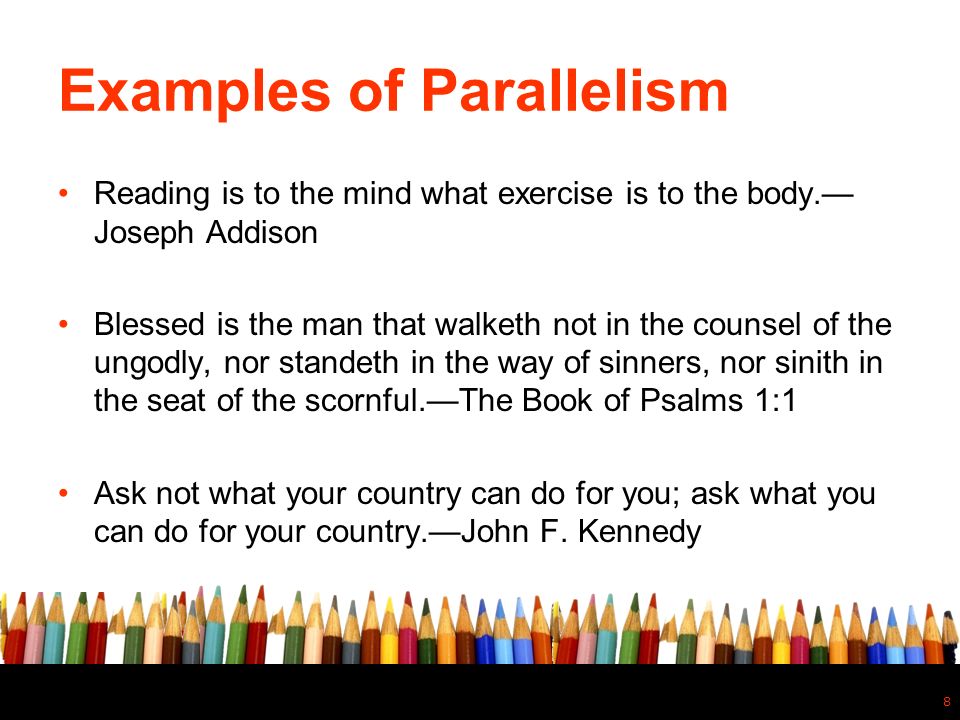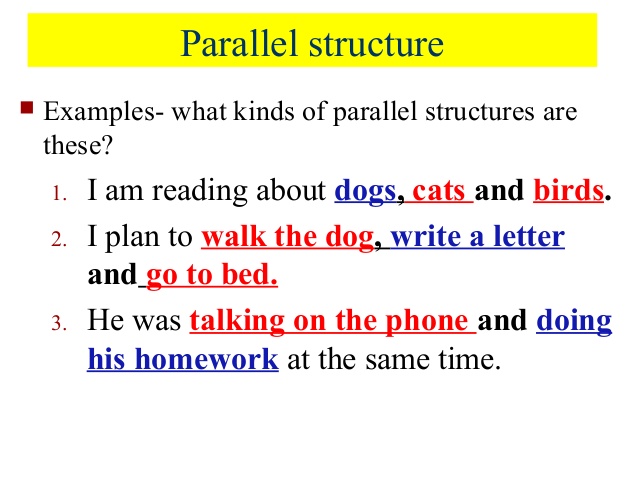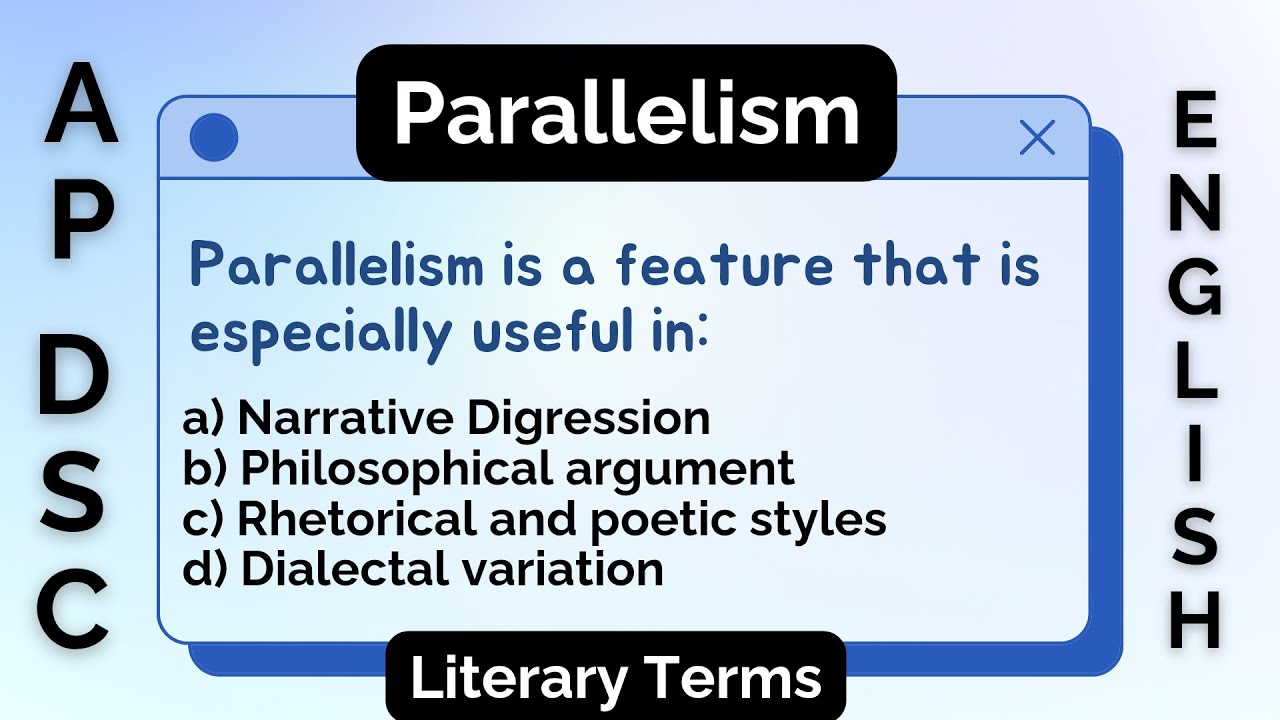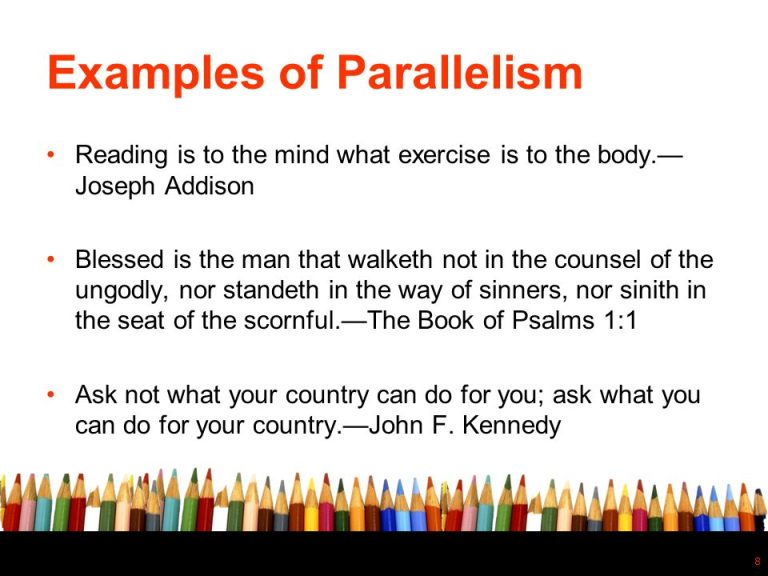Parallelism examples in literature show how writers use matching patterns to create powerful effects in their work. Writers have been using this technique for thousands of years to make their words stick in readers’ minds.
When you read something that feels rhythmic and memorable, you’re probably experiencing parallelism in action.
This writing tool helps authors create balance, emphasis, and beauty in their sentences.
Today, we’ll explore what parallelism means and discover amazing examples from famous books, poems, and speeches.

What is Parallelism in Literature?
Parallelism in literature means using similar grammatical structures in sentences or phrases.
Think of it like a musical pattern where the same beat repeats but with different words.
Writers use parallelism to create rhythm, emphasis, and memorable phrases that readers can’t forget.
This technique involves repeating the same sentence structure while changing the content.
For example, “I came, I saw, I conquered” follows the same pattern three times.
The structure stays the same, but each part adds new information.
Parallelism makes writing sound more professional and polished.
It helps readers follow the author’s thoughts more easily.
When done well, parallel structure creates a hypnotic effect that draws readers deeper into the text.
Types of Parallelism in Literature
Syntactic Parallelism
- Syntactic parallelism focuses on matching sentence structures.
- Writers arrange words, phrases, and clauses in similar patterns.
- This creates a sense of balance and harmony in the text.
- Example: “She was young, beautiful, and intelligent.”
- All three descriptive words follow the same grammatical pattern.
Semantic Parallelism
- Semantic parallelism deals with meaning rather than just structure.
- Writers express similar ideas using parallel construction.
- This type emphasizes the relationship between concepts.
- Example: “Ask not what your country can do for you—ask what you can do for your country.”
- The meaning contrasts, but the structure mirrors perfectly.
Phonetic Parallelism
- Phonetic parallelism uses similar sounds and rhythms.
- Writers repeat sound patterns to create musical effects.
- This type is common in poetry and memorable speeches.
- Example: “Peter Piper picked a peck of pickled peppers.”
- The repeated “p” sound creates a playful rhythm.
Antithetical Parallelism
- Antithetical parallelism presents contrasting ideas in parallel structure.
- Writers use this to highlight differences or create tension.
- The structure remains the same, but the meanings oppose each other.
- Example: “It was the best of times, it was the worst of times.”
- Charles Dickens uses this technique to show contrast.
Famous Parallelism Examples from Classic Literature
Shakespeare’s Masterful Use of Parallelism
- William Shakespeare was a master of parallel structure in his plays and sonnets.
- In “Hamlet,” he wrote: “To be or not to be, that is the question.”
- This simple phrase uses parallelism to create one of literature’s most famous lines.
- Shakespeare also used parallelism in “Julius Caesar”: “Friends, Romans, countrymen, lend me your ears.”
- Each noun in the series follows the same pattern, building emotional impact.
- His sonnets frequently employ parallel structure to enhance their musical quality.
Charles Dickens and Social Commentary
- Charles Dickens used parallelism to highlight social issues in Victorian England.
- His opening line in “A Tale of Two Cities” remains one of literature’s most quoted examples.
- “It was the best of times, it was the worst of times, it was the age of wisdom, it was the age of foolishness.”
- This extended parallel structure creates a powerful contrast between opposing forces.
- Dickens continues this pattern throughout the entire opening paragraph.
- The technique helps readers understand the complexity of the historical period.
Biblical Parallelism in Literature
- The Bible contains numerous examples of parallelism that have influenced Western literature.
- Psalm 23 demonstrates beautiful parallel structure: “The Lord is my shepherd; I shall not want.”
- Many authors have borrowed this biblical style for their own works.
- The repetitive structure creates a meditative, spiritual quality.
- Writers like John Milton and John Bunyan incorporated biblical parallelism into their narratives.
- This technique adds dignity and authority to their writing.
Parallelism in Poetry
Walt Whitman’s Revolutionary Style
- Walt Whitman revolutionized American poetry with his use of parallelism.
- In “Song of Myself,” he writes: “I celebrate myself, and sing myself.”
- His parallel structures create a chanting, almost hypnotic effect.
- Whitman’s long lines often contain multiple parallel elements.
- This technique helped establish free verse as a legitimate poetic form.
- His influence can be seen in modern poets who use similar techniques.
Emily Dickinson’s Subtle Parallelism
- Emily Dickinson used parallelism more subtly in her compact poems.
- Her poem “I’m Nobody! Who are you?” demonstrates parallel questioning.
- She creates intimacy through repeated structural patterns.
- Dickinson’s parallelism often appears in her rhythm and meter.
- This technique adds musicality to her already powerful imagery.
- Her work shows how parallelism can work in shorter forms.
Langston Hughes and Social Justice
- Langston Hughes used parallelism to address social issues in his poetry.
- His poem “Dream Deferred” employs parallel questions: “What happens to a dream deferred?”
- Each stanza follows a similar questioning pattern.
- This technique builds tension and emphasizes the urgency of his message.
- Hughes’ parallelism makes his social commentary more memorable and impactful.

Parallelism in Speeches and Oratory
Martin Luther King Jr.’s “I Have a Dream”
- Martin Luther King Jr.’s famous speech contains powerful examples of parallelism.
- The repeated phrase “I have a dream” creates a rhythmic, inspiring pattern.
- Each repetition builds upon the previous one, creating emotional momentum.
- King also uses parallelism in “Let freedom ring from…”
- This technique helped make his speech one of the most memorable in history.
- The parallel structure made his message easier to remember and repeat.
Winston Churchill’s Wartime Speeches
- Winston Churchill used parallelism to inspire the British people during World War II.
- His famous “We shall fight” speech repeats the same structural pattern.
- “We shall fight on the beaches, we shall fight on the landing grounds, we shall fight in the fields.”
- This repetition creates determination and resolve.
- Churchill’s parallelism helped unite the nation during difficult times.
- The technique made his speeches more powerful and memorable.
John F. Kennedy’s Inaugural Address
- President Kennedy’s inaugural address contains several examples of parallelism.
- His most famous line uses antithetical parallelism: “Ask not what your country can do for you—ask what you can do for your country.”
- This structure creates a memorable call to action.
- Kennedy also used parallelism in other parts of his speech.
- The technique helped establish his presidency with inspiring rhetoric.
Modern Examples of Parallelism in Literature
Contemporary Authors and Parallelism
- Modern authors continue to use parallelism in creative ways.
- Toni Morrison employs parallel structure in “Beloved” to create haunting effects.
- Her repetitive phrases echo the cyclical nature of memory and trauma.
- Morrison’s use of parallelism helps readers feel the emotional weight of her characters.
- Contemporary poets like Maya Angelou also use this technique effectively.
Parallelism in Popular Fiction
- Even popular fiction writers use parallelism to improve their prose.
- J.K. Rowling uses parallel structure in the Harry Potter series.
- Her descriptions often follow similar patterns to create consistency.
- This technique helps young readers follow complex storylines.
- Popular authors understand that parallelism makes writing more engaging.
Parallelism in Song Lyrics
- Song lyrics frequently employ parallelism to create memorable hooks.
- Bob Dylan’s lyrics often use parallel structure for emphasis.
- Hip-hop artists use parallelism to create rhythmic patterns.
- This technique helps listeners remember and sing along with songs.
- Music and literature share many structural similarities.
Benefits of Using Parallelism in Writing
Enhanced Readability
- Parallelism makes writing easier to read and understand.
- Readers can follow the author’s thoughts more smoothly.
- The repeated patterns create a natural flow in the text.
- This technique reduces confusion and improves comprehension.
- Writers who use parallelism help their readers stay engaged.
Improved Memory Retention
- Parallel structures are easier to remember than random patterns.
- The human brain naturally looks for patterns in information.
- Parallelism takes advantage of this natural tendency.
- Readers remember parallel phrases long after finishing the text.
- This technique is especially useful for educational writing.
Greater Emotional Impact
- Parallelism can create powerful emotional effects in readers.
- The repetitive structure builds tension and excitement.
- Writers use this technique to emphasize important points.
- Parallel structure can make readers feel the author’s passion.
- This emotional connection keeps readers engaged throughout the text.
Professional Polish
- Writing with parallelism sounds more professional and polished.
- It shows that the author has carefully crafted their sentences.
- Readers perceive parallel writing as more credible and authoritative.
- This technique is especially important in business and academic writing.
- Professional writers use parallelism to establish their expertise.
How to Create Effective Parallelism
Identify the Pattern
- Start by deciding what pattern you want to repeat.
- Choose whether you’ll use words, phrases, or entire clauses.
- Make sure the pattern serves your overall purpose.
- The pattern should enhance your message, not distract from it.
- Practice identifying patterns in your favorite authors’ work.
Maintain Consistency
- Keep the same grammatical structure throughout the parallel sequence.
- Don’t mix different types of words or phrases.
- Consistency is key to effective parallelism.
- Check that each element follows the same pattern.
- Read your work aloud to catch inconsistencies.
Use Appropriate Length
- Don’t make your parallel sequences too long or too short.
- Three to five elements usually work best.
- Too many elements can overwhelm readers.
- Too few elements might not create the desired effect.
- Adjust the length based on your specific purpose.
Choose Strong Content
- Make sure each element in your parallel sequence adds value.
- Don’t include weak or unnecessary elements just to maintain the pattern.
- Strong content is more important than perfect structure.
- Each element should contribute to your overall message.
- Quality should always come before quantity.
Common Mistakes to Avoid
Breaking the Pattern
- Don’t mix different grammatical structures in the same sequence.
- This confuses readers and weakens the effect.
- Keep the pattern consistent throughout the entire sequence.
- Check each element carefully before finalizing your text.
- Inconsistent patterns are worse than no parallelism at all.
Overusing the Technique
- Don’t use parallelism in every sentence or paragraph.
- Too much parallelism can become monotonous.
- Use this technique strategically for maximum impact.
- Save parallelism for your most important points.
- Balance parallel structure with varied sentence patterns.
Sacrificing Meaning for Structure
- Don’t force parallelism if it hurts your message.
- Clear communication is more important than perfect structure.
- Sometimes breaking the pattern serves your purpose better.
- Use parallelism to enhance your meaning, not replace it.
- Your content should always be your top priority.
Ignoring Context
- Consider whether parallelism fits your writing style and audience.
- Formal writing may require different approaches than casual writing.
- Academic papers need different techniques than creative writing.
- Match your parallelism to your overall tone and purpose.
- What works in poetry might not work in technical writing.

The Psychology Behind Parallelism
Pattern Recognition
- The human brain naturally seeks patterns in information.
- Parallelism satisfies this psychological need.
- Readers feel satisfied when they recognize repeated structures.
- This recognition creates pleasure and engagement.
- Writers who understand this can better connect with their audiences.
Cognitive Processing
- Parallel structures are easier for the brain to process.
- The repeated pattern reduces cognitive load.
- Readers can focus on content rather than structure.
- This makes complex ideas more accessible.
- Parallelism essentially makes writing more user-friendly.
Emotional Response
- Repetitive patterns can create emotional effects.
- The rhythm of parallelism can be soothing or exciting.
- Writers use this to influence their readers’ feelings.
- The technique can create anticipation or resolution.
- Emotional engagement keeps readers interested in the text.
Teaching Parallelism to Students
Age-Appropriate Examples
- Use simple examples for younger students.
- “I like pizza, pasta, and ice cream” works well for beginners.
- Gradually introduce more complex parallel structures.
- Connect parallelism to students’ favorite songs and movies.
- Make the technique relevant to their lives.
Practice Exercises
- Have students identify parallelism in their favorite books.
- Create exercises where students fix broken parallel structures.
- Encourage students to write their own parallel sentences.
- Use peer review to help students improve their technique.
- Practice makes parallelism become natural for writers.
Assessment Strategies
- Include parallelism in writing rubrics.
- Teach students to self-assess their parallel structures.
- Provide clear feedback on parallel structure attempts.
- Celebrate successful use of the technique.
- Help students understand both the rules and the exceptions.
Future of Parallelism in Literature
Artificial Intelligence and Writing
- AI writing tools are learning to use parallelism.
- These tools can identify and suggest parallel structures.
- However, human creativity remains essential for effective parallelism.
- Writers must still understand when and how to use the technique.
- Technology enhances but doesn’t replace human literary skill.
Emerging Literary Forms
- New forms of literature continue to use parallelism.
- Interactive fiction employs parallel structures.
- Multimedia storytelling adapts the technique for digital formats.
- The core principles remain relevant across new mediums.
- Parallelism evolves but maintains its essential power.
Global Literature Exchange
- International literature sharing increases parallelism variety.
- Writers learn from different cultural approaches.
- Translation challenges help refine the technique.
- Global perspectives enrich local literary traditions.
- The technique becomes more diverse and inclusive.
FAQs
What are 5 examples of parallelism?
-
Easy come, easy go.
-
She likes cooking, jogging, and reading.
-
He came, he saw, he conquered.
-
The teacher told us to study, to revise, and to succeed.
-
Whether in class, at work, or at home, he is always busy.
What is an example of a parallel in literature?
In A Tale of Two Cities by Charles Dickens: “It was the best of times, it was the worst of times…” uses parallel structure to emphasize contrast.
What is a famous example of parallelism in speeches?
Martin Luther King Jr.’s “I Have a Dream” speech: “I have a dream that one day… I have a dream that…” shows repetition and balance.
What is a real world example of parallelism?
Slogans like Nike’s “Just do it. Own it. Win it.” or lists in everyday instructions: “Clean the room, fold the clothes, wash the dishes.”
What are 5 examples of parallel lines in real life?
-
Railway tracks
-
Zebra crossing stripes
-
Window blinds
-
Edges of a notebook
-
Shelves in a bookcase
What are the 10 examples of euphemism?
-
Passed away (for died)
-
Let go (for fired)
-
Between jobs (for unemployed)
-
Senior citizen (for old person)
-
Economical with the truth (for lying)
-
Correctional facility (for prison)
-
On the streets (for homeless)
-
Intimate apparel (for underwear)
-
Big-boned (for overweight)
-
Pre-owned (for used)
Conclusion
Parallelism examples in literature demonstrate the timeless power of structured repetition.
From ancient religious texts to modern social media posts, this technique continues to captivate readers.
Writers who master parallelism can create more memorable, impactful, and professional content.
The technique works because it aligns with how our brains naturally process information.
Understanding parallelism helps both writers and readers appreciate the craft of good writing.
Whether you’re analyzing literature or creating your own content, parallelism offers a valuable tool for communication.
The examples we’ve explored show how this technique transcends genres, cultures, and time periods.
As literature continues to evolve, parallelism will undoubtedly remain a fundamental element of effective writing.
Start incorporating parallel structures into your own writing and discover the difference it makes.
Your readers will thank you for the clarity, rhythm, and memorability that parallelism provides.

